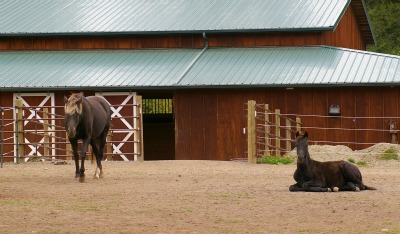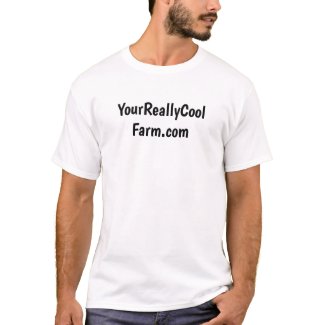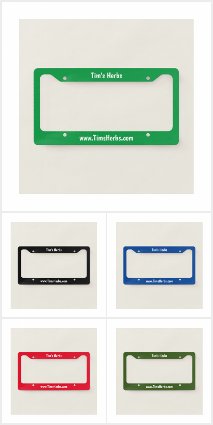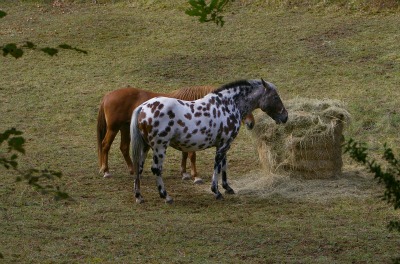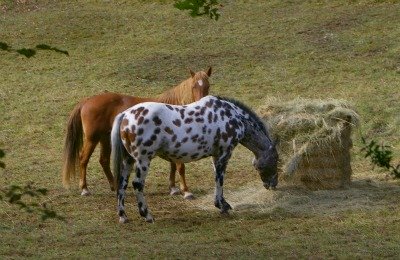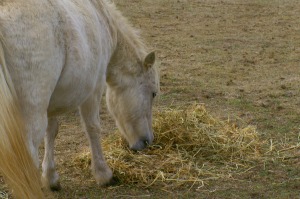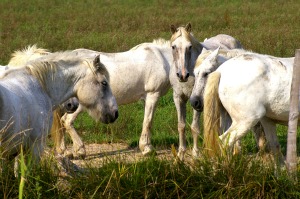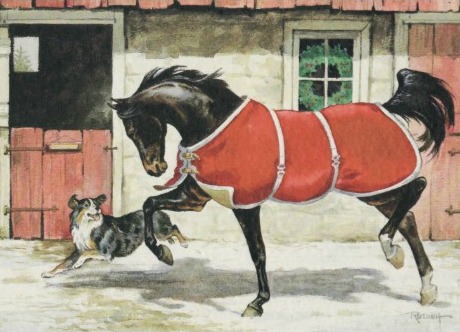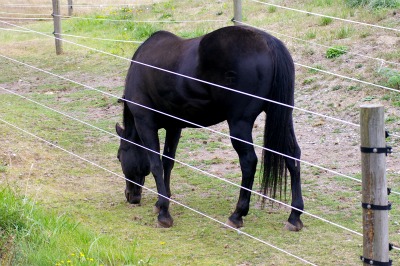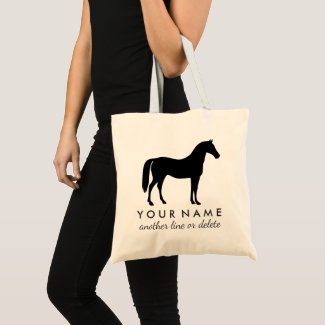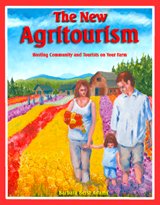© National Lilac Publishing, LLC
The natural horse farm Part II: Methods taken from the wild to create a brand new type of horse ranch of almost any size (read part I here)
Do horses need to be so expensive to care for? Do they have to take up so much space that could be used for other purposes, like raising cash crops or wildlife habitat?
In Part I of this article we learned how pleasure horses or ponies themselves helped add fertility and revenue to their owners’ farms and ranches. But what if the cost and labor of their care could be slashed or even eliminated? What if the acreage needed to keep them healthy could be cut way down, while giving them more exercise, hoof health and general health than ever before?
Similar to the Permaculture method of planning a farm or ranch, to create something so much better down the road, it may temporarily take upfront restructuring, one-time new costs, and learning new skills. But for some of the horse owners and ranches you’ll read of below, the rewards of eventual cost and health relief are even beyond what they initially hoped for.
Note, though, that this article isn’t about the very basics of horse care and assumes the reader has some knowledge already. The reader hopefully already knows that a backyard pony or unwanted horse hauled home for free for the kids can be “cheap,” but suffer immeasurably without proper care specific to its species. Their suffering can include feet so painful they can hardly stand, intestinal spasms, and desperate attempts to get proper nutrition by chewing on wooden fences, all from the unaware human doing what he or she thought was right, putting the pony on their nice green lawn in a large fenced segment of their backyard.
But those with serious involvement with horses also know you can worm, drench, vaccinate, exercise twice a day, feed, treat, cover, buy gadgets and pay vets and trainers to remedy destructive behaviors and illnesses until you have to take a second mortgage out on the house. Some are finding a better way.
CUTTING COSTS WITH NATURAL CARE
Business is very big, and entrenched, when it comes to pushing the high end of medical and chemical care insisted upon for the show, breeding, pleasure, pet and race horse industry. More natural horse care can greatly whittle down this expense, as it is for a growing number of horse owners.
Natural Boarding and Care
Feeding area: I took these photos of the two beautiful horses in France as they first tried to knock hay out of the feeder, and then proceeded to eat it off the ground.
In nature, most of the horses’ grazing, with the exception of occasional browsing on higher branches or hills, is spent with the head low at ground level, which causes the center of gravity to be ideal for the horse. In contrast, unnatural feeding in some boarding situations forces much of the feeding to be in special (and sometimes costly) feeding racks with the head held too high for too long, according to those who promote natural feeding situations. This causes unnecessary stress on certain tendons, ligaments and perhaps even the respiratory system. When possible, simply feed horses on the ground.
Horse expert, Jaime Jackson, whom you’ll read much more about below, has traveled with wild horses for years, and is now a sought-after expert on various natural horse care methods. He said this about possible “sand” or “mud” colic that some owners are concerned about when horses eat straight from the earth:
“I think concerns over "sand colic" have stemmed from the finding of sand in the gut of horses surgically treated. However, the presence of sand in the gut may be natural. No research has shown that sand is or isn't present in the guts of healthy wild, free-roaming horses, who navigate over sandy terrain daily in search of food. There is compelling evidence that colic most likely results from stress -- from unnatural boarding conditions, including unnatural diet and restricted movement, isolation from other horses, and fear of human meddling. My advice: hay on the ground.”
Personally, I feel that even in the wild, horses will avoid muddied or sandy grass and forage. I still put hay above ground in those conditions. But otherwise, they get hay fed on the ground.
Improving traditional pasture for cutting health costs, cutting cost of feed, and space conservation
According
to those experienced with natural horse care, it is possible to
eliminate the time and expense of regular worming, vaccinations, and
treatments for other non-existent health problems when there's a
balanced trace mineral-grown and more naturally diversified pasture, where the horse’s
instincts and
growing plants do much of the work and eliminate much of the cost.
Treatment then becomes an occasional issue, not an ongoing unnecessary
expense.
First, though, do you even want to pasture your horses? Beautiful photographs of “country life” depict horses on huge fields of manicured brilliant green. But in reality, this doesn’t always work for all horse owners for both financial and horse health reasons. Though various extension agents report the right pasture mix can provide very good nutrition for the horse, farmers and ranchers often don’t want to take up space only for horse grazing, which can typically mean two acres per horse.
Plus, for health reasons, while there is debate as to the exact cause of founder and laminitis in horses, some feel that lush green pasture in general will cause this painful affliction, and that large amounts of green are not the natural diet of the wild horse. Others agree somewhat but still insist the more natural diversified grass meadows of older Europe once kept horses much healthier, growing a variety of tall-growing grasses such as perennial rye grass, meadow grass, soft rushes, and others, along with wild herbs and hedgerows to diversify the feed. The photo above left is another I took in France of wild horses dozing in a very diversified wild meadow. It may look like a monocrop of green grass from a distance, but it's loaded with diversity.
Still others feel the issue of horse health including founder and laminitits is more a mineral imbalance, and if horses get the right balance of minerals, founder won’t be an issue. Perhaps, even in the wild, it all depends on the native soil content and the mineral content of the grazing and browsing plants that particular area provides, and wild horses just don’t survive in areas of incorrect mineral balance, while where they do survive, horses instinctively choose wild foods that balance out their minerals.
In the wild, there are hundreds of food choices horses can choose from, whereas in a human-created pasture, the horse has little choice, and can become accustomed, as we humans with our ice cream and donuts, to a less healthy but rich-tasting diet.
Another factor in founder is how often the horse moves. In the wild, horses move regularly for miles every day of their lives. On open pasture, even with plenty of space to romp and with regular rides with humans, horses still don’t cover this much ground 24/7. It seems the typical open pasture invites a form of lethargy with only the occasional romp and play time chosen by the horses. We’ll address the idea of proper minerals below, and a new method to give horses more exercise by actually taking them out of both open pasture and confined paddocks further down.
Add all the earth’s minerals in natural balance for horses to consume
As a horse and pony owner for four decades, I’ve experienced both theories about pasture and founder to be true: that pasture causes founder, and that pasture doesn’t. As a young girl and teenager, our family’s horses and ponies couldn’t touch pasture without serious founder. It was an ailment we were always fighting at great labor and expense. Upon moving to another seaside area of the country with a different pasture pre-planted by a previous farmer, along with natural browse and hedgerow, our horses never foundered, even on thick green pasture.
We always introduced them to new spring growth very slowly and carefully after a winter of supplemental hay, but not a single case of founder showed up regardless of breed of horse. Pat Coleby, author of Natural Horse Care, explains that founder is caused by a diet with excess phosphates without magnesium to balance it, and she teaches horse owners how to treat both chronic and acute cases of laminitis with Epsom salts (magnesium sulfate), dolomite and other minerals. To prevent it in the future, she then says to make sure their regular feed isn’t too low in magnesium nor too high in phosphorus.
As
another example of the benefits of proper mineral balance, Pat further
relates the story of Dr. William A. Abrecht who proved that when
animals’ systems contained the right amount of copper in balance with
other minerals that block its possible toxicity, they were never
bothered with interior parasites. He explained that the copper didn’t
kill the parasites per se, they just wouldn’t stay inside the animal if
there was the correct balance of copper (meaning not too much, not too
little, and with all other minerals in balance with it). More and more
horses, and the wallets of more and more ranchers and private horse
owners, are benefiting from this discovery. (Again, TOO MUCH COPPER IS TOXIC, DO NOT SIMPLY ADD COPPER AS AN INDIVIDUAL MINERAL).
“When I was in Australia, someone gave me a book to read, Natural Horse Care by Pat Coleby,” said horse trainer Linda Parelli (see more about her below), during an interview to Lisa Ross-Williams, host of the "If Your Horse Could Talk" radio show. “I opened the book while lying in bed and thought, whew, this is interesting. When I got to the page that listed all the symptoms according to certain deficiencies in minerals, it was text book for what the horses were experiencing. One of the symptoms of copper deficiency are worm infestations, as well as things like wood chewing, fungal infections, cribbing, abscesses, dry coats, loss of hair color and many others. Textbook for what our horses were starting to exhibit on a larger and larger scale every year since living on this property. With some research on the property, we found there was a massive copper deficiency.
"We put the horses on Pat Coleby's system with a very basic mineral supplementation; not using chelates, but natural occurring minerals. Within three months our horses were transformed; coats changed, tails changed, feet changed and we stopped getting strangles. In the past, we had foals born with contracted tendons. Two foals’ crops now, we've had only one very slight case, zero worm counts. If we do have any count at all, it's very low. So now, all of our ranch horses haven't been wormed in two years and they've never been healthier. We have over 100 horses on the ranch with extremely low vet bills. Very exciting.”
Readers of AcresUSA are often more familiar than others with the studies being done on the benefits of seaweed in various agricultural applications. Rather than offering a high amount of a few trace minerals via mineral blocks, kelp offers every mineral the earth provides in a specific balance that makes them all work together properly. It is also reported to contain algin, which is believed to remove heavy metals from the body, to have antioxidants, and to induce a high level of activity involving replacement of cells. Wild grazing and browsing animals living close enough to the ocean have long been reported to take seaside jaunts to nibble on seaweed.
Other horse owners suggest free choice unrefined sea salt harvested from unpolluted sources. Although it can also be added to feed, according to Don and Ruth Ann Stewart, proprietors of the natural animal and gardening supplier, The Holistic Horse, “The best way is the free choice, and you do need it under a cover.” Horse owners who follow this advice agree that if we mix the salt in with their grain or other feed, it doesn’t allow the horse to choose salt when and if it needs it. It has to get more feed than it wants to get more salt, and visa versa.
But putting out buckets of sea salt allows the horse to use its instincts to keep its body mineralized. In the wild, horses far from beaches regularly travel to salt beds, sometimes the remains of ancient sea beds, solely for the purpose of ingesting salt. Don and Ruth Ann state that unrefined sea salt contains close to 80 minerals in perfectly balanced form, some of which are desperately needed, but only in minute amounts in conjunction with the others. Commercial trace mineral blocks only offer a few in comparison, making it possible for the horse to get too much of some, and none of the others.
Add herbal feeding grounds and free-choice hedgerows as food and medicine.
Wild horses are designed to thrive on a huge variety of food options. Plus, they’re adapted for an almost continuous uptake of food, nibbling here and there as they cross the miles. In captivity, we may make them wait for “breakfast and dinner time” and restrict their diet to only a dozen or so food choices, if even that. This is completely foreign to how horses are meant to eat, and can leave them unable to find the minerals they crave, as in the wild, along with salt beds, they can nibble on deep-rooted bushes and herbs to find inland salt sources. We can remedy this situation by finding a way for them to enjoy continuous food uptake of a high variety with free choice deep-rooted herbs and browsing plants. And by constructing a system where much of this more natural diet grows on its own, horses can freely follow their instincts to choose the foods they most need for their health, and the human guessing and regulated feeding times and can be cut back.
Herbs, such as the dandelion with its deep taproot, and other browse can be allowed in the pasture to help balance out the horses’ nutrition, even if only along the edge, planted in a small designated section, or reaching into the pasture from a hedgerow on the other side of the fence. Hedgerows can add immensely to your horse’s diet, and when done properly, can even be the fence in some cases. They are a great way to re-create wild diversity for your horse. Sometimes called the “European long acre,” horses, donkeys, goats, the family cow, and other livestock were once tethered at the beginning of a hedgerow, gradually moved along it, and finally returned to the fully recovered beginning, when peasant European farmers had no acreage of their own.
The animals were extremely healthy and received all the nutrition they needed in these highly varied hedgerows, including tender herbs and grasses that grew beneath them. I’m not recommending tethering here, but showing the history and potential of adding hedgerows along with your horses’ other healthful living quarters. Horses love to nibble on certain barks, twigs, herbs and tree branches, and hedgerows also provide a perfect environment for ground-growing herbs that don’t grow out in the open and trafficked areas. This way, horses can self-supplement and self-medicate following their natural instincts. Those who observe horses and other grazing animals note that they will not touch certain herbs, such as wormwood, unless it’s absolutely necessary, and even then, only a specific amount. Wormwood fed as a regular supplement in a good-tasting feed ration or well-intentioned ‘natural’ wormer can be toxic.
Although some report that a horse which has been fed a limited captive diet and let out on pasture will sometimes be so happy to consume anything different, fresh, and live, it may not yet be operating from its deadened instincts, and eat too much of a plant it otherwise shouldn’t have. Most feel their instincts will rapidly return. “I believe firmly,” said Jaime Jackson, “that horses, given options, will not choose to consume toxic plants. Domestic horses turned loose into the wild, immediately begin to adapt. However, no studies of the animal's native ethology have been conducted to evidence whether the dietary adaptation is wholly, or partly, or not at all, due to socialization through band/herd participation.” Horses with a lifetime of unnatural captive feed might benefit from gradual reintroduced to live diversified food, especially along with other adapted horses, starting with a full stomach of their usual diet and a handful of greens you’ve chosen yourself to be safe, to keep them from gorging at first release on the wrong plants.
There is no one-recipe-fits-all for herbs and hedgerows for every horse in every bio-region, but my own horses’ pasture consists of seasonal varied grass and very light legume pasture mixed with plenty of herbs, including chamomile and dandelion, plus hedgerow browse that includes wild roses, nettle, and willow, and supplemental grass hay, kelp and sea salt. I’ve noticed, in general, they won’t touch the fresh nettle until it has fallen and dried. They seem to love this “nettle hay.”
Other hedgerow plants suggested by enthusiasts of livestock hedgerows include hawthorn, birch, and hazel. Wild rose, or close relatives to it, are preferred over domesticated roses. These and hawthorn provide therapeutic fruits for humans as well, and their thorns help prevent over-eating and over-trampling by the horse, which protects the herbs and tender grasses growing beneath it, encouraging the horse to lightly browse only when needed.
Other
herbs, both beneath the hedgerow or growing in the main field can
include aniseed, borage, burnet, corn flowers, comfrey, chamomile,
dandelion (highly recommended), dill, evening primrose, eyebright,
fennel, feverfew, garlic (as close as possible to wild garlic),
horehound, horse radish, meadow sweet, milk thistle, millet, mints,
parsley, red clover, rosemary, rue, sage, shepherds purse, St. John’s
wort, thistles (keep in check, but a few can be valuable), wild basil,
wild lettuce, wild marjoram, wild thyme, and wormwood. These are meant to be available if the horses senses they are needed, but never as a food source the horses are forced to eat.
When making your choices, keep in mind what was stated above about whether or not a domestic horse has had a chance to prove its instincts are in tact for choosing proper herbs, and that debate is going on as to the toxicity of some herbs, such as comfrey. While horses seem to love an endless supply of dandelion, natural horse experts agree that like all medicines, many of these herbs will only be mildly nibbled on as a form of medicine or occasional extra supplement when the horses needs it, not consumed as a regular and major part of the diet. Herbs that spread rapidly, like the mints, can be potted or surrounded in a manner that contains them but that has a smooth edge that won’t cut the horse’s muzzle, and set periodically along the horse’s browsing area.
To further mimic the wild, set up a no-labor way for dryland and moist loving herbs to be available to the horse. In the section on Paddock Paradise below, a more natural watering system is described. While we’re discussing hedgerows here, consider locating one of your natural watering holes up against the hedgerow area, with a drip run-over. This allows the more moist-loving herbs such as comfrey and mint to thrive, while the ones preferring drier land can proliferate on higher and drier ground elsewhere.
Young hedgerows are usually protected for the first year or two with inexpensive electric fencing. Once the herbs and hedgerow are established and thriving on their own, your horses will do their supplementing and medicating for you, and your labor and their health costs will be reduced.
Consider pasture rotation if using pasture
Hedgerows add additional food to your pastures, allowing the pasture size itself to be smaller and additional feed to be cut, but the system of pasture rotation that many natural dairies and other ranches now employ can work well for horses if you do choose to pasture them, often creating more pasture in less space with quicker pasture regrowth with the same number of animals as when they were all put into one large area to graze to the ground. For rotational grazing with horses, pastures are subdivided into smaller paddocks, the number depending on how many paddocks you need in order to remove the horses to a new one when the pasture is grazed below three or so inches, and then allowed to regrow without horses to above six inches. If there is one hedgerow edging the back of all these smaller paddocks, it, too, will recover faster and add to the nutrition as described above.
Depending on your soil and climate, each section is usually rested for at least a month at a time, longer in some summer drought and winter conditions. There is no magic number to determine the size, timing and number of sections needed for pasture recovery, so some horse owners begin experimenting with inexpensive portable electric horse tape and step-in posts for determining where to put more permanent rotational fencing in the future. Some just stay with the electric fence. When experimenting and planning, consider that some horse herds are more sedate, while others that include mixed sexes or younger horses need more room to romp and kick and will be harder, traffic-wise, on the pastures they graze on.
Extension agents suggest starting slowly and with your best pasture, subdividing larger than predicted at first to watch how the horses behave and how the pastures recover. Continue subdividing until the right size and number is reached, and consider adding a well-drained designated sacrifice paddock in with the system for when harsher than planned weather doesn’t allow the other sections to recover as usual, such as an unexpected drought or longer and harder than normal freeze.
Once the larger animals are removed from a paddock, either drag the pasture or allow chickens (see below) to enter the field to remove parasites, aerate and spread manure naturally. Reseed any sparse areas in the fall or spring. Rotational grazing should help you get much more pasture acreage for the number of horses you own. Assuming you have no problems with founder or laminitis and pasture, it will add to the horse’s health, cut down on the amount of total pasture needed, and cut into your feed bill. “Paddock Paradise” described below offers an alternative to rotational pastures for horses which some find superior to any other horse boarding system.
Eliminate the building of expensive extra stables or, restore all or most of an existing barn for storage, workshop space or other farm endeavors.
In a natural setting, horses are outdoors without shelter, and depend on their own bodies’ ability to adapt to temperature changes. Often even in strong weather, they prefer to be out in the open where they can better see and listen for possible danger or predators. They will seek the occasional shelter of a tree, cliff overhang, or snuggle with the rest of the herd, but too many horse blankets or too much time spent in the enclosed barn can make their immune systems lazy, because temperature change can be healthy for horses. Yet to keep horses outdoors year-round must be done properly.
By all means, don’t expose a thin-haired horse to the elements or suddenly turn a horse accustomed to a barn out in the snow in the winter. Horses can bypass their instincts over years of human intervention, and many have heard the stories of horses who have come to see the barn as safety, even when it’s the barn itself that’s on fire, with the horses inside refusing to get out in spite of human coaxing. Work carefully with the horse and perhaps an expert on natural horse care to see if you can gradually adapt the horse back to more natural conditions.
And while it may be okay to groom and bathe horses in warm weather, deep cleansing in winter can remove the natural winter protection and water resistance of horses’ skin and coats, and they will need protection until it returns. “My belief is that all horses are genetically capable of "winter coating,” said Jaime Jackson. “At least, this seems borne out by the wild horse model. Much of the confusion surrounding adaptability follows, once more, directly from human meddling which can interfere with natural papillation mechanisms so that the horse's epidermal armor fails. Not because it is incapable of adaptation, only that boarding conditions obstruct the adaptation process.”
Unless you must deeply groom your horses throughout winter, you may find you don’t need an expensive barn or stables at all, but rather a few trees and a smaller open-air storm shelter, along with a small tack shed with covered grooming area for show or riding preparation. If you’re a hopeless romantic (like I am) when it comes to traditional farm and ranch architecture and simply must have the large, lovely stables and/or big barn, build them (or renovate your current ones) into structures for other uses, including an apartment loft for visitors, farm tool storage, or a garden shed. But it appears your horse’s health and immune system in many cases may be stronger if they can remain outdoors year-round.
Horse gifts! T-shirts, vintage horse print cards, horse wrapping paper, posters, calendars, more!
Remove outdated shoeing and hoof trimming methods
The Houston Police Department’s Mounted Unit used to use metal shoes for their horses, and now rides them barefoot with the occasional use of a “hoof boot.” They learned through a workshop on natural hoof care that horseshoes can be the cause of both expensive physical ailments and behavioral problems. Wild horses gallop across hard, rocky, dry landscapes in the harshest of nature’s environments, and slosh through water and mud, yet have outstanding, strong feet and few of the health problems that captive horses have.
Their hooves are in almost constant, direct contact with the earth. Science is now looking into the benefits of the bare-foot-to-bare-earth connection, even for humans. Search your local area for bare-foot trimmers to see how to help your horse develop strong hooves without ever having to shoe them.
There are also solutions, now, for the horse with healthy bare hooves that occasionally needs to walk on unnaturally harsh surfaces, such as riding the horse in the occasional parade on asphalt. Specially made hoof boots mentioned above can be worn for extra protection during these occasions without the expense, perpetual disconnection with the earth, and health problems associated with ongoing horse shoeing.
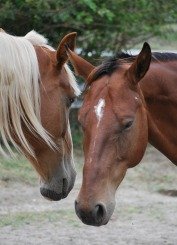
Insist on a companion
Fewer horses might often mean less expense. But horses were made by nature to live amidst complex social structures with other horses. A lone horse is under chronic stress -- its instincts telling it that it's been abandoned without protection of the herd and danger is lurking. Therefore, it's a less healthy horse. Consider ways to add companionship without adding expense. Team up with others involved in natural horse care who want to own horses if you want only one for yourself, perhaps trading pastures with all horses together as a land-owner teamwork form of pasture rotation.
Check with your insurance provider about having each member of this team sign a waiver for when on each others’ property, letting the agent know this is a friendship agreement and not a paid boarding situation (paid services sometimes have higher insurance costs). Ask what other coverage or precautions should be taken care of for the safety of all. Or, set up a minimal natural boarding or horse leasing situation on your property with one or two other horse lovers who don’t own their own land, making sure their fees meet or exceed your added liability coverage, labor and expenses.
For
a less complicated method that doesn’t involve other riders on your
property, rescue a healthy free or inexpensive pony or miniature horse
or two that were outgrown, forgotten, or didn’t meet the show
requirements. Be careful, there are reports of large breeds, such as
thoroughbreds, playfully kicking their miniature horse companions and
causing injury or death, so while you’ll want your companion horses to
be as small as possible for less feed and space they take up, do take
the size of all horses, as well as the reactions related to mixing
genders, into consideration when choosing a companion. In the wild, an
alpha male and alpha female control the entire herd. Two alphas together would be a recipe for misery for the third lone weaker one.
The younger wild colts that become bachelors lower in the pecking order, and the young filly daughters, are eventually ousted from the main herd. In captivity, these and other social measures aren’t necessarily acted on, but if possible, make sure the companion is a match for both before a commitment is made, letting them get to know each other gradually before making a final decision. If you own a gelding, another gelding partner can create a social situation similar to the wild bachelors that band together, and can make a good companion. Geldings’ behaviors with mares depend a lot on the individual horse and how “studly” he still acts around females.
Start taking “natural” horse training seriously
This article doesn’t cover riding nor horse training per se. But from the perspective of avoiding the high cost of horse care in general, here’s a story from Linda Parelli, quoted from the radio show described above. She helps her husband, Pat Parelli, teach and spread the word about natural riding. She shares the story of how she met Pat, bringing him her horse that was so troubling, so impossible to control, she’d been told more than once to have the horse put down.
After working with Pat, she was very quickly riding this horse with no saddle or bridle, no longer needing what she describes as “$200 worth of gadgets” to try to control this animal. Linda Parelli, and Leigh Shambo interviewed in Part I, and others agree it’s more about the human finding inner balance and offering that to the horse when it comes to the kind of almost magical results from natural horse and rider training.
While Linda put a
concrete price on the gadgets she no longer needs because of natural
riding and training, I’ll leave it to the reader to put a price tag on
the value of preteens who appear to be going through the expensive
“horse stage” to the detriment of their parents, but becoming healed
from within while pursuing that hobby. If you’re going to the expense of
horse and rider training anyway, give horse whisperer techniques a
second glance, they may save countless dollars down the road.
Sharing pastures with wildlife, other livestock, and other farm or homestead projects
Horses sometimes seem expensive to the farm and the environment because of the large amounts of exclusive pasture they utilize that could be used for other, possibly more financially productive livestock or, at least for wildlife habitat. But horse pasture can double as pasture for other farm animals, act as a wildlife sanctuary, and even grow some crops for humans at the same time. Fertile, diverse pastures, especially those with trees and hedgerows, can become a mecca of wildlife activity that operates well alongside horses.
The wildlife ranges from threatened tree frogs to small native mammals to resident and migratory birds and pollinators which will find food, shelter and nesting in the hedges, trees, and occasionally in the herbal meadows and even on the backs of the horses. Hedgerows, which horses will nibble at infrequently, and designated herbal browsing areas, can double as a place to grow herbs, wild rosehips, hawthorn berries, basket willow, hazelnuts, and other products for humans.
Horses have been successfully rotated with other species in a manner that benefits all species involved. For example, horses like some pasture plants that sheep prefer to ignore, and sheep enjoy and eliminate problem plants for horses.
With two different forms of grazers and/or browsers, the pasture is kept in a better balance for both. But what about grazing more than one species at the same time, rather than using rotation? Multi-species grazing is hotly debated, no doubt because some studies show serious problems with mixing species together in the same area, and others show huge benefit.
As time passes, we’ll come to know why some situations of multi-species pasturing cause the problems, how to fix those problems, and why some bring benefits, and to build on the benefits. We’ll most likely discover that healthy soils, diversified pastures with herbs and wild plants, and healthy intestinal flora play a large role in whether animals can graze beneficially together. Right now, two combinations that show promise include grazing chickens with horses. The chickens eat parasites, scratch and aerate the soil, and spread the manure. The other is grazing goats with horses.
Goats tend to keep brambles at bay and eat weeds that horses shun, and horses eat what goats more often ignore, both creating better pastures for each other. Parasites of goats do not affect horses, and visa versa. But both goats and horses have specialized nutrition requirements, and problems can occur when wanting to give different supplements to different species, when one could be toxic to the other. This is where a pasture with soil optimum microorganisms and probiotics, diverse deep-rooted grazing edibles, and naturally balanced trace minerals once again comes to the rescue.
Supplements of any kind may be eliminated altogether, along with their cost and labor. If species-specific supplements do need to be given, a program can be set up where only the goats, for example, can reach through to the area where special supplementation is offered, and the horses are supplemented in a manner that goats can’t reach, as long as it’s very temporary and/or very infrequent, so the horse isn’t consuming too much with its head held high.
Introducing Paddock Paradise - Giving horses more exercise by taking up less space
In the wild, horses travel for many miles every day, which keeps them in top shape from head to hoof. They don’t stand around locked in small paddocks or barns. However, Jaime Jackson, the natural horse care expert who traveled for years with wild horses, reports in one of his books, Paddock Paradise, that when visiting a 20,000 acre ranch that allowed 100 rescued horses to roam at will, he found even with that amount of space, horses often stood lazily around and showed similar signs of ill health as horses locked in smaller areas. It seems horses once again can be a little too much like humans. Given too many remote controls, or too much ‘meaningless’ open space in which to laze around, and humans and horses don’t fulfill their own nature-created bodies’ needs for lots of physical activity. Then health problems set in.
So, what if you could eliminate much of the space used up for traditional horse pasturing and free it up for other farm activities, free horses from small paddocks by not using hardly any more space than you already were using, while giving horses more exercise than the 20,000-acre ranch? Nope, not a giant horse-sized hamster exercise wheel.
Jaime discovered that in the wild, horses, in a way, do create their own ‘fences’ and boundaries, and follow specified loops or tracks, traveling extensively along these tracks for miles every day of their lives. Because of these herd-created boundaries, wild horses aren’t exactly free to just lope across the plains towards the sunset on a whim as we might imagine from Hollywood movies, at least not if the alpha mare and alpha stallion have their way (which they always do).
These tracks are sprinkled with natural temptations to urge horses to move forward continually. They give focus and meaning. Endless, pointless open space in the form of large, often rectangular pastures, conversely, causes eventual lethargy. And of course, small captive paddocks don’t offer the space for exercise, either.
Here’s how this adaptation of wild horse health, exercise and hoof care can be recreated. Imagine a four acre rectangle pasture fenced at its outside perimeter. Horses are grazing inside of it. Now, add another inexpensive electric fence inside the outside fence perimeter about 15 feet in, creating a continuous 15-foot wide loop that rings the property.
Put the horses in, and see that they can follow this “track” around and around and around for miles in a day if they choose. Will they choose? Why would they keep moving on such a track when they just stood around for the most part when they were in open pasture? Well in nature, horses travel on their tracks to their watering hole, then on to the salt beds, then to herbal meadows, then to areas good for rolling, then to meadowy eating grounds, then to hedges good for browsing, then to another watering hole, then to good camping for nighttime, and then they start all over again.
In the Paddock Paradise system, horses are put on a connected loop which mimics a track that can be almost any shape or size, it doesn’t necessarily have to run the entire perimeter of your property, which isn’t practical in many cases, anyway. Then, along the way, create destinations that are put a distance apart: free choice minerals and salt in one area, then various hay and feed in another and so on, including kelp supplement areas, watering areas, rolling areas and “camping” grounds spaced apart to move the horses continually forward. Jaime explains it all in his book, Paddock Paradise, as well as in a planned online forum where horse owners can compare their experiences and help the system improve. One owner with a pasture-foundered mare set up this system in one day. He put his horses in, including the foundered mare, and saw positive changes almost immediately.
Even though she ate some of the grass still growing in this fenced track, her founder began to dissolve. However, when the season changed and the natural grass began to grow extensively in the track, the horses inside didn’t find the need to move as often, and started lazing around more, eating a lot more green grass, almost as they had done when on larger pasture. Their health began to reverse again. The owner, thinking he’d have to remove all grass from the track and/or make the track narrower, first tried adding another horse instead. In short time, the additional horse and regular traffic wore down the track to where excess grass was no longer a problem, without any human labor to keep it down. The horses naturally moved forward on the track as before, and their health again showed incredible recovery and benefit. Like rotational pastures, it may take some experimentation to determine the width and other factors that will provide the perfect track for your horse situation.
In
a crude and accidental way, I had a similar system for my horses, but
also had added hedgerow feed and even a form of rotational grazing to
the system. Remember, the horses in my location don’t appear to founder
on pasture, so this isn’t recommended for those that do. As my horses
moved along their track, I would occasionally open up a gate along their
route that lead to a very small paddock pasture where the meadow had
grown tall enough, opening, then closing, different small pastures along the
track’s way always closing the previous one off to recover.
The horses never knew when or if a new one would be open, keeping their curiosity strong and the horses moving onwards. But for those with pasture and founder problems, Jaime shows that Paddock Paradise, once adjusted properly to keep problem grass out, can keep horses continuously exercised, filled with diverse feed and minerals, and yet off lush pastures to avoid any type of founder or laminitis. Paddock Paradise also describes the ‘track’ of wild horses, offers templates for setting up your own track within a traditional open pasture, describes methods more natural watering holes where horses are allowed to get their feet, if not their entire bodies, into the water at will, and where they can drink with the head low to the ground.
It takes upfront big picture planning and foresight to integrate horses into a natural, self-sustaining infrastructure on each individual eco-farm. Many of us already have traditional rectangular split pastures for our farm animals, so a new plan has to be devised if we want to try the tracking and hedgerow systems. The main expenses are usually in the beginning, and this is also usually the time with the most difficulty in thinking out of the box. “Current business thinking,” including those who make their money from metal horseshoeing, aggressive training and its equipment, or selling conventional medications, will resist and find fault wherever possible. And Paddock Paradise as well as all more natural systems are in perpetual evolution and experimentation.
But more and more farriers are learning new barefoot trimming techniques and selling hoof boots, hedgerow plants, herbal meadow seed, and herbal supplements instead. And trainers and horse boarders are restructuring their workshops and facilities. The model you may create upfront can bring far less cost to horse care for years down the road while it brings farm fertility, financial reward, a closer kinship to nature, and more pleasure to your horses, you, your children and your grandchildren for generations to come.
RESOURCES:
Fertility Pastures by Newman Turner
An old classic focusing more on dairy farming than horses, but gives a good introduction to the loss and restoration of natural meadows and hedgerows vs. modern pasturing systems. It's available from AcresUSA.
_______________________
See also our articles on how farmers find ways to fully protect and insure their farm businesses with sometimes very low (or even free) yearly insurance costs:


